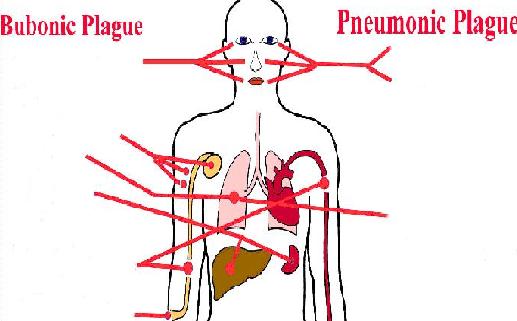PNEUMONIC PLAGUE
Of all forms of the disease, pneumonic plague develops most rapidly and is most frequently fatal. The incubation period for pneumonic plague is 1 to 4 days. The start is often sudden, with chills, fever, headache, myalgias (muscular pain), weakness, and dizziness. Pulmonary signs, including cough, sputum production, chest pain, typically appear on the second day of illness and may be accompanied by blood, respiratory difficulties, and circulatory problems.
Pneumonic plague is highly contagious. Person-to-person transmission is easy in cold humid environments and it requires face-to-face exposure within 2 metres of the coughing patient.
In primary plague pneumonia, the sputum is often mucous, and it may become bloody. Pulmonary signs like necrosis (dead tissue) and cavitations (holes in the lungs) may occur early.
Secondary plague pneumonia manifests first with sputum production.
Observers remarked on the frequency of sudden death in patients with pneumonic plague as compared to patients with other bacterial pneumonias.
Previous public health guidelines have advised strict isolation for all close contacts of patients with pneumonic plague.
Modern experience with person-to-person spread of pneumonic plague is limited; few data are available to make specific recommendations regarding appropriate infection control measures. The available evidence indicates that person-to-person transmission of pneumonic plague occurs via respiratory droplets.
